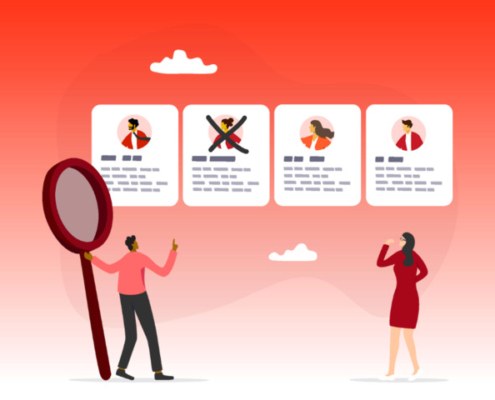

In B2B marketing, reaching your ideal business customer isn’t the end-all-be-all. It’s about understanding the path that leads you there, filled with opportunities to connect and engage with your audience meaningfully. Merging what your audience needs with your marketing goals creates a synergy that garners attention while cultivating loyalty and growth.
Let’s explore the art and science of delivering content that hits all the right notes with your audience, turning potential customers and casual readers into loyal clients.
Use this guide and learn to:
Establish Your Content Distribution Goals
Setting clear goals for your content distribution strategy is key to ensuring your efforts lead to tangible results. Without defined goals, your content might lack direction and purpose. Here’s a breakdown of how to set effective goals and measure your success in a B2B context.
Define Your Purpose
Before diving into content creation and distribution, ask yourself: What do you want to achieve with your content? Common goals include:
- Increasing Brand Awareness: Make your brand more recognizable and reputable within your industry.
- Driving Traffic to Your Website: Attract potential customers to your site to learn more about your offerings.
- Boosting Sales: Convert leads into paying customers by guiding them through the sales funnel.
Each of these goals requires a tailored approach and specific metrics to track progress.
Setting SMART Goals
One effective method for setting goals is to use the SMART criteria:
- Specific: Clearly define what you want to achieve.
- Measurable: Ensure you can track your progress with quantifiable metrics.
- Attainable: Set realistic goals that are achievable with the resources available.
- Relevant: Align your goals with broader business objectives.
- Time-Bound: Set a deadline for achieving your goals.
For example, if your goal is to increase Marketing Qualified Leads (MQLs) by 20% within the next quarter, you can break this down into specific actions:
- Creating Informative Whitepapers: Develop content that addresses the needs and pain points of your target audience.
- Optimizing Landing Pages: Ensure your landing pages are designed to capture leads effectively.
- Implementing Lead Nurturing Campaigns: Use email campaigns to engage and convert leads.
Using SMART goals ensures your content distribution strategy is focused, trackable, and aligned with your overall business objectives, making success more attainable.
Determine Your Objectives
To set effective objectives, understand your company’s current position and future aspirations. If your aim is to increase market share, focus on content that highlights your unique selling points (USPs). For example, create case studies that showcase successful projects or customer testimonials that emphasize your product’s benefits.
If your goal is to enhance engagement, produce content that fosters deeper relationships with your current clients. This could include:
- Informative Blog Posts: Share insights and industry trends to keep your audience informed and engaged.
- Helpful Guides and Tutorials: Provide value by helping your audience solve common problems.
By clearly defining your objectives, you can create content that is aligned with your business goals and resonates deeply with your target audience.
Establish Key Performance Indicators (KPIs)
KPIs are essential for measuring the success of your content distribution efforts. They translate your goals into measurable outcomes. Here are some KPIs to consider:
- Lead Generation: Track conversion rates, cost per lead, and the number of qualified leads generated.
- Engagement: Monitor social shares, comments, and the average time spent on your content pages.
- Brand Awareness: Measure the reach and impressions of your content, as well as brand mentions across social media.
Are you tracking the right KPIs for your content marketing success? Keep an eye on your conversion rates to ensure your content marketing strategy is on track for success!
Learn More: Crucial Content Marketing KPIs
Align KPIs with Business Goals
Ensure your KPIs reflect your broader business targets. If your company aims to penetrate a new market segment, monitor content consumption rates within that group. If customer loyalty is your focus, track repeat interactions and increased subscription rates.
Ask yourself:
- Why is this KPI relevant to our overall business objective?
- What insights can we gain from this metric?
- How does measuring this KPI improve our content distribution efforts?
For instance, if your goal is to increase brand awareness in a new market, a relevant KPI might be the number of new followers or subscribers from that region. This data helps you understand if your content is resonating with the intended audience.
By setting clear, actionable goals and aligning your KPIs with your business objectives, you can create a content distribution strategy that effectively reaches and engages your target audience. This strategic approach ensures that all your efforts contribute to the overarching vision of growth and success.
Research and Understand Your ICP
Researching and understanding your ideal client profile (ICP) is a critical first step in developing an effective B2B content distribution strategy. By knowing who your ideal customers are, you can create content that addresses their specific needs and distribute it through the channels they frequent.
Learn how to gain valuable insights into your content’s effectiveness and make data-driven decisions to refine and optimize your distribution strategy.
Properly Identify the Industry
Understanding the industries your target audience belongs to is everything to a marketing team. Different industries have unique characteristics, challenges, and communication styles. For example, content tailored for the healthcare industry is miles apart from content aimed at the tech sector.
To gather this information, you can:
- Analyze Your Current Customer Base: Look at the industries your current clients belong to. Ask yourself: “Are my ideal clients in manufacturing, cleaning, or another nice?
- Conduct Market Research: Use industry reports and market analysis to understand the sectors that need your products or services.
By following these steps and applying these insights to your content strategy, you ensure that your content is relevant, valuable, and tailored to the needs of your target audience.
Recognize Pain Points
Identifying the common pain points or challenges your target audience faces in their daily operations will help you create content that provides real value.
To discover these pain points, consider:
Conduct customer surveys and interviews that directly ask your existing customers about their challenges. Engage in industry-specific forums like LinkedIn groups, Quora, and Reddit to see what issues are frequently discussed.
For instance, if you find that a common pain point for your audience is the complexity of regulatory cybersecurity compliance, you can create content that simplifies and explains these regulations.
Determine Key Decision Makers
In B2B marketing, it is vital to know who the key decision-makers are within your target organizations and which stages of the buyer’s journey they are in. These individuals will ultimately approve purchases or partnerships.
Identify the decision-makers specific job titles and roles. For example, are you targeting CTOs, marketing managers, or procurement officers? Then, understand what influences their decision-making process. Is it cost, efficiency, innovation, or something else?
This knowledge helps you tailor your content to address the specific concerns and priorities of these decision-makers.
Choose the Right Content Types
Different audiences have different content preferences. Some may prefer in-depth whitepapers, while others might engage more with short, informative blog posts or videos.
To determine the preferred content types of your ICP:
- Analyze Engagement Metrics: Look at which types of content have performed well in the past.
- Ask Your Audience: Conduct surveys or polls to find out what type of content they prefer. For example, if your audience consists of busy executives, they might prefer concise, actionable insights delivered via infographics or short videos rather than lengthy reports.
Choosing the right content types ensures that your content resonates with your audience and maximizes engagement.
Identify Preferred Channels
Knowing where your target audience spends their time online is essential for effective content distribution.
To find out which platforms are most popular among your ICP:
- Check Industry-Specific Communities: Platforms like LinkedIn are good places to start.
- Conduct Online Searches: Use tools like Google Trends or social listening tools to see where your audience is most active.
- Monitor Competitor Activity: See where your competitors are most active and successful in engaging your shared target audience.
For example, if your research shows that your target audience is highly active on LinkedIn but not as much on Twitter, focus your efforts on creating and distributing content through LinkedIn.
Learn More: Building Buyer Personas
Create an Editorial Schedule
Creating an editorial schedule is a critical component of an effective B2B content distribution strategy. It acts as a roadmap that ensures consistency, organization, and alignment across your content creation and distribution efforts. Let’s dive into the importance of an editorial schedule and how to set one up properly.
Why You Need One
An editorial schedule helps you plan and organize your content in advance, ensuring that you maintain a steady flow of content without overwhelming your team or audience. Here are some key benefits:
- Consistency: Regular publishing keeps your audience engaged and coming back for more. An editorial schedule helps you maintain this consistency.
- Alignment: It ensures that everyone on your team is on the same page regarding what content is being created, when it will be published, and how it will be promoted.
- Efficiency: Planning your content ahead of time allows you to allocate resources effectively and avoid last-minute scrambles.
- Strategic Planning: It provides a clear view of your content strategy, making it easier to align your content with business goals, key events, and marketing campaigns.
With these benefits, you can lighten the mental load of everything that goes into your marketing plan, which makes a world of a difference.
Four Steps to Create an Effective Editorial Schedule
1. Choose Your Tools
There are various tools available to create and manage your editorial schedule. Some popular options include:
- Asana: This project management tool offers visual boards, task assignments, and timeline features to keep your content creation and distribution organized.
- Monday.com: A flexible work operating system that allows you to customize your editorial calendar, track progress, and collaborate with your team seamlessly.
- HubSpot: Provides robust features for planning, scheduling, and tracking your content, along with integrated marketing tools to enhance your overall strategy.
- Google Calendar: A simple yet effective tool for scheduling content and setting reminders, ensuring you stay on top of deadlines.
- Microsoft Excel or Google Sheets: These versatile tools allow you to create customized editorial calendars and format and organize data according to your needs.
Keep in mind that selecting the right tool depends on your team’s specific needs and workflow preferences.
2. Identify Key Information
Your editorial calendar should contain essential details to guide your content creation and distribution. Here’s what to include:
- Content Formats: Specify the type of content, such as blog posts, whitepapers, videos, or infographics.
- Titles and Topics: Outline the working titles and topics of each content piece.
- Keywords: Identify the primary keywords to target for SEO purposes.
- Distribution Channels: Determine where each piece of content will be published and promoted, such as your website, social media, email newsletters, or industry forums.
- Publication Dates: Set deadlines for drafts, reviews, and final publication.
- Authors and Contributors: Assign responsibility for creating and editing each piece.
- Repurposing Plans: Note opportunities to repurpose content for different formats or platforms.
This simplifies things for all parties involved and presents greater opportunities to identify gaps in content strategy.
3. Set Your Publishing Frequency
Determine how often you will publish content based on various factors. Reflect back on your ICP and audience preferences, industry norms, and more to determine how frequently you should publish. Consider seasonal fluctuations and trending topics in your sector and prioritize quality over quantity.
4. Plan for Repurposing Content
Resharing and repurposing existing content can save time and resources while extending its life. For example, turn a well-performing blog post into an infographic or a series of social media posts. This approach ensures you get the most value out of each piece of content.
Putting It In Practice: Creating an Editorial Schedule
Let’s say you manage a cybersecurity solutions company. Here’s how your editorial schedule might look:
Week 1
Monday: Blog Post – “Top Cybersecurity Threats in 2024” (Author: John, Keywords: cybersecurity threats, Publication: Website, Promotion: LinkedIn, Twitter)
Wednesday: Infographic – “How to Protect Against Phishing Attacks” (Designer: Emma, Keywords: phishing protection, Publication: Website, Promotion: Instagram, Pinterest)
Friday: Whitepaper – “Comprehensive Guide to Cloud Security” (Author: Sarah, Keywords: cloud security, Publication: Website, Promotion: Email Newsletter)
Week 2
Tuesday: Case Study – “How XYZ Company Improved Security Posture” (Author: Mark, Keywords: case study, security improvement, Publication: Website, Promotion: LinkedIn, Twitter)
Thursday: Video – “Cybersecurity Best Practices for Small Businesses” (Producer: Anna, Keywords: cybersecurity best practices, Publication: YouTube, Promotion: Facebook, LinkedIn)
This schedule ensures a balanced mix of content types and distribution channels, keeping your audience engaged while aligning with your business goals. By creating and adhering to an editorial schedule, you can streamline your content distribution efforts, ensuring they are both effective and efficient.
Create and Align Your Content
By this point, you’ve done enough planning. Now, it’s time to create your content!
Here are some key areas to focus on:
Optimize for Search Engines
Search engine optimization (SEO) is key to increasing the visibility of your content. Start by conducting keyword research to identify the terms your target audience is searching for. Implement these keywords strategically throughout your content to improve its ranking on search engine results pages.
For instance, if you’re targeting the cybersecurity sector, use keywords like “cybersecurity solutions,” “data protection strategies,” and “cyber threat prevention.” Optimizing your content for SEO will help attract a larger audience and drive organic traffic to your site.
Cultural Marketing
Understanding your audience’s culture and values is vital for creating content that resonates with them. Tailor your content to reflect the cultural context of your target market. For instance, if your audience values sustainability, produce content that highlights your company’s eco-friendly practices and initiatives. This culturally sensitive approach helps build stronger relationships and avoid misunderstandings.
Expert Insights
Including insights from industry experts can help establish your brand as a thought leader. Collaborate with experts to create valuable content such as interviews, guest posts, or expert roundups. For example, you could publish an interview with a well-known industry leader discussing future trends and challenges. This not only adds credibility to your content but also provides valuable information to your audience.
Brand Storytelling
Storytelling helps build brand awareness and create an emotional connection with your audience. Share compelling stories about your brand’s journey, values, and successes. For example, create a blog post about a customer’s success story using your product or service. This not only highlights the benefits of your offering but also fosters trust and loyalty among your audience.
Additional Content
This content includes small, easily digestible pieces like social media posts, infographics, and short videos. These types of content are perfect for capturing your audience’s attention quickly. For example, a compelling infographic that highlights industry trends can drive engagement and lead traffic to your website. Short videos, such as product demos or quick tips, can be shared on social media platforms to keep your audience informed and interested.
It’s time to start creating content that’ll stand out. Abstrakt is here to help you earn more traffic and more potential customers! it’s not just about stuffing your content with keywords. Our expert copywriters know how to create engaging and informative SEO content. Explore our services.
Switch It Up
In B2B marketing, sticking to just one type of content can limit your reach and engagement. Experimenting with different types of content allows you to find out what resonates most with your audience and keeps them engaged.
Why Experiment with Different Content Types?
There are a few reasons why you need to switch things up from time to time:
- Diverse Preferences
Not all your audience members consume content the same way. Some might prefer reading detailed reports, while others might engage more with videos or infographics. By offering a variety of content types, you cater to different preferences and capture a broader audience.
- Increased Engagement
Different content types can drive varying levels of engagement. For example, videos might get more shares on social media, while whitepapers might generate more leads. Experimenting helps you identify which formats work best for your goals.
- Enhanced Reach
Different platforms favor different content formats. Blog posts and articles might perform well on LinkedIn, while short videos and infographics could be more effective on Twitter and Instagram. Using various formats ensures your content reaches your audience wherever they are.
With this knowledge, you should learn which content formats work best under certain situations.
Effective B2B Content Formats
Some of the most common and effective B2B content formats include:
- Blog Posts: Great for sharing insights, industry news, and thought leadership pieces. Regularly updated blogs can improve SEO and drive organic traffic to your site.
- Whitepapers: In-depth reports that provide detailed information on a specific topic. Ideal for generating leads as they can be gated content that requires contact information to access.
- Case Studies: Showcase your successes and provide real-world examples of how your products or services have solved problems for clients. They build credibility and trust.
- Infographics: Visually appealing and easy to digest. They can simplify complex information and are highly shareable on social media.
- Videos: Engaging and versatile. Use them for product demos, customer testimonials, or explainer videos. Videos often have higher engagement rates on social platforms.
- E-books: Comprehensive guides on a particular subject. They can be used to educate your audience and are excellent for lead generation.
- Webinars: Live or recorded sessions that allow for interaction with your audience. They are great for in-depth discussions and demonstrating expertise.
By experimenting with these different formats, you can discover what works best for your audience and continuously refine your B2B content distribution strategy.
Make a Decision On Your Marketing Channels
You’ve identified your clientbase’s preferred channels, but now, it’s time to make a decision about the precise type of channels you will go through to distribute your content. Each channel type—owned, earned, and paid—has its own benefits and considerations. Here’s how to decide which channels to use:
Owned Channels
Owned channels give you full control over your content and messaging. You can tailor content specifically to your audience and measure its performance. Examples include:
- Websites
- Blogs
- Social Media Accounts
This medium offers complete control over content, tailored messaging, and measurable engagement. However, it’s limited to reaching only your existing audience and does not guarantee new customer acquisition.
Earned Channels
Earned channels rely on organic promotion and word-of-mouth to distribute content. They enhance credibility and can reach new audiences. This is most commonly through media coverage, such as articles and mentions in industry publications, social media posts and interactions that amplify your content, and guest posts on other platforms to reach new readers.
While this brings increased credibility, a broader reach, and cost-effectiveness compared to paid channels, there is a lack of control over distribution. Many marketing strategists find there’s an overreliance on others to share your content.
Paid Channels
Paid channels involve investing resources to promote content. They guarantee visibility and offer precise audience targeting. Common examples include:
- Social Media Ads: Targeted advertising on platforms like LinkedIn, Twitter, and Instagram.
- Search Engine Ads: Paid placements on search engine results pages (SERPs).
- Sponsored Content: Paid articles or posts on relevant blogs or social media.
Paid channels are great for securing a garanteed reach, precise targeting, and measurable ROI. Hoever, potential drawbacks include higher costs compared to organic methods, requiring consistent performance to justify investment.
Choosing the Right Channels
When deciding on your content distribution channels, consider these factors:
- Audience: Where does your target audience spend their time? Choose channels they actively engage with.
- Goals: Determine whether your primary goal is brand awareness, lead generation, or thought leadership.
- Budget: Allocate resources effectively between owned, earned, and paid channels based on your budget constraints.
- Strengths and Weaknesses: Evaluate each channel’s strengths in reaching your audience and its weaknesses in terms of control and cost.
By strategically balancing owned, earned, and paid channels in your content distribution strategy, you can maximize reach, and engagement, and ultimately achieve your B2B marketing objectives effectively.
Learn More: Guide to Multi-Channel Marketing
Practice Content Audits and Refine Your Strategy Over Time
No good marketing strategy lasts forever. Regularly auditing and refining your B2B content distribution strategy is essential to maintaining relevance, optimizing performance, and achieving long-term success.
Why Implement Regular Content Audits?
Here’s why you should implement content audits:
- Evaluate Content Effectiveness: Conducting a content audit allows you to assess how well your content aligns with your business goals and resonates with your target audience. Analyze metrics such as engagement rates, conversion rates, and SEO performance to gain insights into what works and what needs improvement.
- Identify Opportunities for Improvement: A thorough content audit helps pinpoint outdated, redundant, or underperforming content. By removing or updating such content, you can enhance user experience, improve SEO rankings, and streamline your content library.
- Optimize Resource Allocation: Understanding which types of content perform best can guide future content creation efforts. You should always be reallocating resources to create more of what resonates with your audience, you ensure your content strategy remains aligned with evolving market trends and audience preferences.
How to Conduct a Content Audit in Four Steps
So how does the content audit process typically go? There are a few methods, a simplified, stripped-down version of the process:
1. Create a Comprehensive Inventory: Start by compiling a spreadsheet listing all content pieces on your website or other channels. Include key metrics such as traffic, engagement metrics (like bounce rate and time on page), and conversion data.
2. Analyze Performance: Review the data to identify patterns and trends. Focus on high-performing content that drives traffic and conversions, as well as low-performing content that may need improvement or removal.
3. Update and Repurpose Content: Based on your findings, update outdated content to reflect current information and trends. Repurpose successful content into different formats (e.g., turning a popular blog post into a webinar or infographic) to extend its reach and engagement potential.
The Final Step: Assess, Refine, and Update
Continuously assessing, refining, and updating your content ensures it remains relevant and effective in meeting your business objectives. By leveraging data-driven insights from content audits, you can refine your content distribution strategy to better engage your B2B audience and achieve sustainable growth.
Key Takeaways
Implementing an effective B2B content distribution strategy involves understanding your target audience, setting clear goals, and continuously refining your approach to ensure engagement and growth. By aligning your content with your audience’s needs and utilizing the right marketing channels, you can build strong connections and foster client loyalty.
For businesses looking to enhance their online presence, Abstrakt Marketing Group offers expert SEO content marketing services that drive traffic, build credibility, and increase awareness. Our team creates high-quality, SEO-friendly content that helps you stand out in search engine results and connect with your target audience. Speak with one of our experts today!










